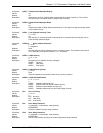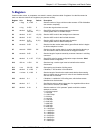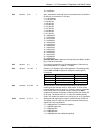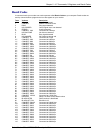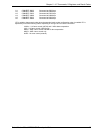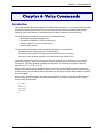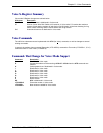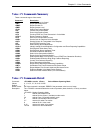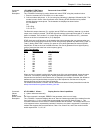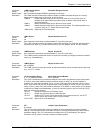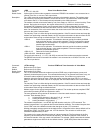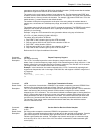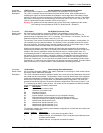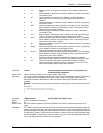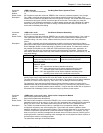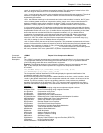
Chapter 6 – Voice Commands
SocketModem Global MT5634SMI Developer’s Guide 47
Command: +FCLASS=8 DTMF Detect Detect and Control DTMF
Values: 8 characters, case sensitive
Description: The +FCLASS=8 command is used to detect and control DTMF using the procedure below:
1. Enter the command AT+FCLASS=8 <cr> to the modem.
2. Call into modem with phone. A Ør (incoming ring indication) is displayed, followed by OK. The
modem is now in Online Voice Command mode, allowing DTMF characters to be passed
through from the remote phone. The characters are displayed as shown below:
AT+FCLASS=8
OK
ØR is Ring
Ø/Ø1Ø1Ø~
The Data link escape character (Ø), and the ‘start of DTMF tone shielding’ character (¤) are both
output once a button is pressed. The DTMF digit will continue to be output along with a Ø until the
button is released. Then another Ø is output along with a ‘DTMF transitions to off’ (~) character.
Silence on the line is indicated with a (Øs) displayed.
DTMF (dual tone multi frequency) is the signal to the phone company that you generate when you
press an ordinary telephone’s touch keys. DTMF has generally replaced loop disconnect (“pulse” or
“rotary”) dialing. With DTMF, each key you press on your phone generates two tones of specific
frequencies. So that a voice can’t imitate the tones, one tone is generated from a high-frequency
group of tones and the other from a low frequency group.
Touch Tone Signals
Digit Low frequency High frequency
1 697 Hz 1209 Hz
2 697 1336
3 697 1477
4 770 1209
5 770 1336
6 770 1477
7 852 1209
8 852 1336
9 852 1477
0 941 1336
* 941 1209
# 941 1477
When any key is pressed, both the high and low tones of the row are generated, hence the name
“dual tone”. For example, pressing the ‘5’ button generates the tones 770Hz and 1336Hz. The
frequencies were chosen to avoid harmonics (no frequency is a multiple of another, the difference
between any two frequencies does not equal any of the frequencies, and the sum of any two
frequencies does not equal any of the frequencies).
For additional information on DTMF, see the Telecommunications Industry Association’s web site
at http://www.tiaonline.org/resources/other_links.cfm.
Command: AT+FCLASS=? <Enter> Display Service Class Capabilities
Values: 0, 1 (other values are reserved)
Default: 0
Result Codes: OK if the command is accepted; ERROR if the parameter value is out of range.
Description: The +FCLASS=? command displays the set of Service Classes supported by the modem from the
list of values (e.g., 0,1 for a modem that supports data comm plus fax Service Class 1). This
command returns the service class or classes available with the modem. The modem returns a list
of all supported values, separated by commas if more than one class is supported. For example, a
modem that supports data communications, Class 1 fax, Class 2 fax, and Voice mode functions
would respond with "0,1, 2.0, 8".



